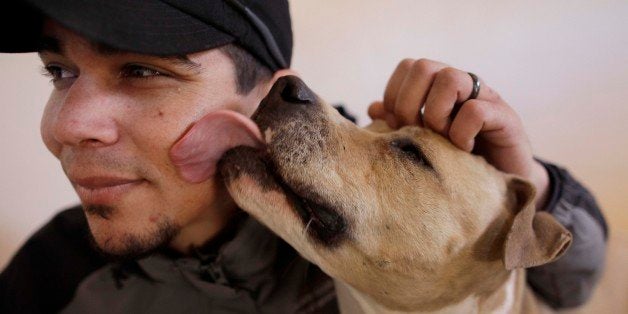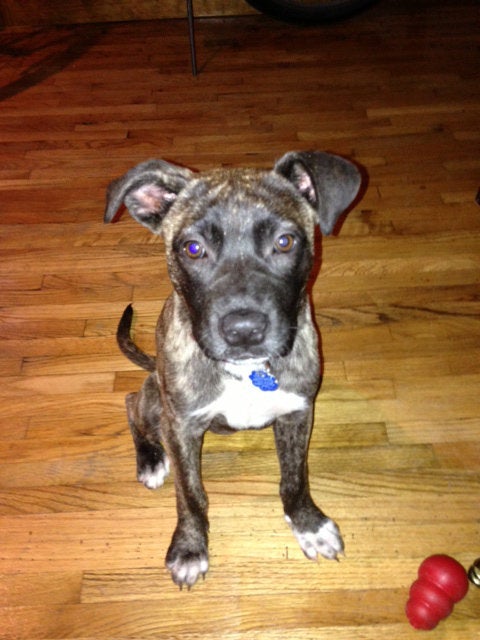
"Beware the Jabberwock, my son!
The jaws that bite, the claws that catch!"
Lewis Carroll -- "Jabberwocky"
Reading the myths regarding pit bull terrier-like dogs is like dipping into fantasy: "they bite harder than any other breed", "they have locking jaws", "they are ticking time bombs waiting to go off in your living room."
What?
This is all nonsense and the cartoon monster that it describes may as well be the Jabberwock, except for the fact that the pervasiveness of this myth is responsible for tens of thousands of very sweet pit bull terriers languishing and dying in America's shelters.
The extremity of the scare narrative around pit bull terriers tends to give rise to an equally false counter-narrative by some pit bull rescuers suggesting that all pit bulls are just plug and play roly-poly, cuddle muffins.
The fact is that pit bull terrier-like dogs are just that -- dogs. And, like all dogs they are domesticated animals that have been selectively bred over thousands upon thousands of years to be socially responsive to humans and trainable for good or ill.
The fact is that all dogs have teeth and all dogs can bite -- the larger the dogs the stronger the bite. Pit bull terriers are in the middle of the pack for bite strength among dogs of comparable size.
All dogs require training and socialization with other animals and with people beyond their immediate family. Whether that's formal training aimed at passing a Canine Good Citizen test, or just routine, positive exposure to other people and pets from puppyhood, socialization is essential for any dog, especially medium to large size dogs whose bad behavior can have serious consequences. If any dog is intentionally or unwittingly encouraged to be aggressive or protective or neglected and left to figure out social behavior on their own, an out of control canine is the likely result.
As with Dobermans before them and German Shepherds before that and Bloodhounds before that, pit bulls are currently the media's favorite "scary dog." If the 1972 film They Only Kill Their Masters, which featured a Doberman Pincher as the lead suspect in a murder, were to be remade today, a pit bull would undoubtedly be the "canine of interest." But back then it was Dobermans that had the bad rap -- curved ripping teeth, extra strong jaws, blah, blah, blah. The exact same misinformation that has tarred the reputation of pit bull terriers.
While many of these fabrications about the dogs still exist, the war against pit bull terriers is thankfully losing steam. Advocates around the world are winning by simply showing the true nature of these dogs. Pit bull terrier-like dogs are just that -- dogs. They are no different than any other breed. They come in all different shapes, sizes and colors and each of them is an individual.
As recently as 10 years ago, the opposite was true. Hundreds of communities around the U.S. had restrictions in place preventing the ownership of a variety of dog breeds including Rottweilers, Chows and German Shepherds. Usually a measure put in place as a knee-jerk reaction to a dog attack, these blanket policies have been responsible for the deaths of millions of dogs over the years. The problem with these bans, is that they don't actually protect the public because aggression is more a function of training and socialization than it is of breed and there are plenty of non-target-breed dogs with aggression issues in the hands of irresponsible owners.
Dogs, like people are individuals and should be treated and evaluated as individuals, not by the blanket categories of breed or appearance. Do dangerous dogs exist? Of course, and they too come in all shapes and sizes. The realization that we need to treat dogs as individuals thankfully has finally hit the mainstream.
In 2007, Best Friends, along with other organizations, advocated for the safe release of the dogs seized in the Michael Vick dog fighting case. These dogs, regarded even by some traditional animal welfare organizations as irredeemably dangerous by virtue of their breed, turned out to be -- as we suspected -- just dogs.
It is true that many had been trained to fight, but we knew that the same canine qualities and characteristics that Vick and his crew exploited to train negative behaviors, i.e., an owner focused desire to please, could be used to train for good. And for most of those individual dogs that proved to be the case.
We took 22 of the dogs, considered the toughest cases, into our sanctuary in Utah. Since that time, 13 of them were adopted, placed into loving homes, others have become staff favorites and circulate around different offices at the sanctuary while 4 of the 22 Vick dogs that came to Best Friends were too abused and traumatized by their prior experience to be safely placed in situations that would put them in contact with volunteers or the general public.
The legacy of the Vicktory Dogs, as we refer to them, has changed the narrative around every pit bull-like dog. If these dogs in particular, the "most aggressively trained dogs in the country" could be turned around, then what about every other pit bull terrier in any shelter in America? We believe they, too, deserve to be considered as individuals and given a chance to live.
Today, 19 states have pre-emptive laws in place against breed discrimination. That means in those states, no community can discriminate against a particular breed. The American Bar Association (ABA) in 2012 passed a resolution against breed discrimination. A big moment as the ABA carries so much weight in so many different arenas. And beyond the big, state level victories there are smaller wins in courts across America that may have less of an impact in terms of the number of dogs, but the message they send is loud and clear.
Clay, Alabama passed a breed discrimination law in 2013, much to the chagrin of many local residents. The ordinance was challenged in court, and last year a judge ruled the ordinance violated the 14th Amendment of the United States. Meaning it is unconstitutional for the city to discriminate against a dog based solely on its breed.
Next year we hope to add more states to the list of those that do not discriminate. Michigan, Georgia, Missouri and Delaware are four more that are considering passing laws that would prevent any local community from enacting breed discriminatory ordinances. The wins are piling up, and the reason why is very simple. Breed discrimination does not work. It costs taxpayers far too much money to defend and enforce and it does nothing to actually create safer communities. There are some excellent examples today of communities that have passed breed-neutral dangerous dog laws and turned the focus to the real issue -- genuinely dangerous dogs and reckless owners.
At the root of almost every violent dog and dog attack, is a problem owner. Very rarely does a dog attack without some history. Often times, these dogs are found running loose, and are well known to local animal control. Bolstering existing animal care and control regulations to punish irresponsible owners has shown to be very effective in cities such as South Bend, Indiana and Wilmington, Delaware.
It's been far too long in coming and too many dogs have senselessly lost their lives simply for being born with a big head and a muscular looking body, but the tide has turned. There's no doubt that by the end of this decade most of America will be safe for all types of dogs and the "The Jabberwock, with eyes of flame" can go whiffling and burbling back to Victorian fantasy land.
For the second year, The Huffington Post is holding a week-long, community-driven effort to bust the myths and raise awareness about pit bulls, a maligned "breed" that often bears the brunt of dated, discriminatory legislation that can make it near impossible for these dogs to find a forever home. You can follow along with HuffPost Pit Bull Week here, or on social media where we'll be using the hashtag #PitBullWeek.
Also on HuffPost:
